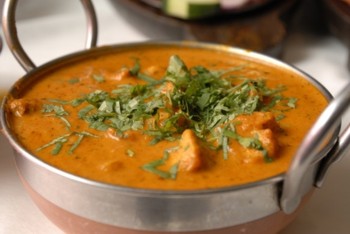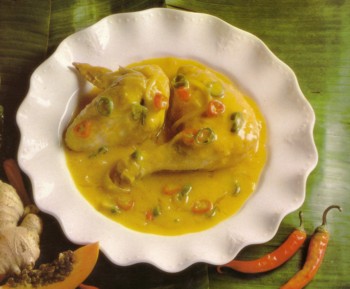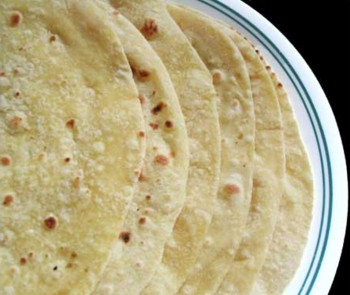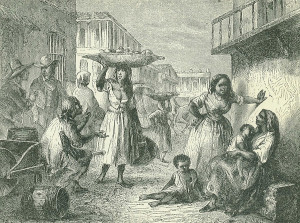by Dave DeWitt
Recipes:Curried Pholourie Pumpkin- Jamaican Curry Goat Pork Colombo from Curried Chicken Trinidadian Curried |
Although curries in some form appear in the cuisines of most of the Caribbean, they are particularly prevalent in the countries where the East Indian population is the greatest: Jamaica, Martinique, and Trinidad and Tobago (T&T).
In 1838, four years after slavery was abolished in T&T, the food history of the two islands began to change profoundly. That year, the mandatory, four-year post-slavery apprenticeship ended and some 20,000 slaves who worked the enormous sugar cane plantations left the estates and became squatters–resulting in an enormous labor shortage.
That shortage was filled by freed slaves from other islands, plus a huge influx of indentured laborers from India. Beginning in 1845, a mass migration of workers from India over the next seventy-two years increased the population of Trinidad by 145,000. By the 1940s, the East Indian influence was so prevalent that travel writer Patrick Leigh Fermor wrote: “Wide tracts of Trinidad are now, for all visual purposes, Bengal.” Because the East Indians were thrown together in a strange land and were forced to share tasks equally, divisions of caste and religion were soon dissolved. The Hindus, who formed the bulk of the diaspora, began to eat beef out of necessity. Unlike the Africans before them, the East Indian immigrants were allowed to keep their language, clothing, and food. Two animals that immigrated with them were the water buffalo–useful for heavy labor–and the white, humped cattle that provided the milk for the beloved yogurt and butter, which was made into ghee.
Many East Indian foods and cooking techniques were introduced into T&T, notably curries and rice (rice is still grown in Trinidad today). Curries have become enormously popular in the country, as noted by calypso writer Daisann Mclane: “Without access to their curry,” she wrote, “Trinidadian cooks would be as lost as Sicilians without fresh garlic.” There are several incarnations of curry. First, there are masalas, which are spice blends usually without chile powder or turmeric–these are the mildest blends that are added to cooked meats and vegetables. The phrase garam masala literally means “hot spices.” Amchar masala, a blend of coriander, fenugreek, fennel, mustard, and cumin, is commonly used to season cooked green mangos (amchar is the Hindi word for mango).
Then there are commercial curry powders, such as the Raja Jahan brand, which contains coriander, cumin, turmeric, fenugreek, celery seed, fennel, and mangril, a mystery ingredient variously identified by the locals as curry leaf or poppy seeds. Most likely, the word is a corruption of the Hindi word mangrail, which is onion seed. Other popular commercial curry powders are Turban (manufactured since 1929), Chief (which contains black pepper), and Indi, a Guyanese brand containing some hot peppers. A typical commercial mixture usually contains varying amounts of coriander, cumin, turmeric, fenugreek, celery seed, and fennel. The curry powder capitol of Trinidad and Tobago is Tunapuna, a town about halfway between Port of Spain and Arima. Daisann McLane vividly described it in 1991: “Clouds of roasted cumin and turmeric, garlic, coriander, and those acidly hot Caribbean peppers…simply by breathing, one was exposed to hazardous levels of piquant longing.”
Most of the curry powders made today are much milder than those of India because the early cooks lacked powdered hot peppers. However, hot pepper sauces are often added to curried dishes at the table. Some cooks still use old-fashioned curry pastes, which usually have Congo peppers (a Habanero relative) added to them, and our recipe for Trinidadian Curry Paste (here) is a typical example.
Every imaginable foodstuff is curried in Trinidad and Tobago, including mangos, pumpkins, eggplants, potatoes, green tomatoes, okra, chicken, fish, shellfish, beef, pork, goat, and lamb. These curries are commonly served in roti shops which dot the two islands. The curried mixture is placed upon the flat, thin roti bread, and then is wrapped up into an easy-to-eat package of curry.

Mary Jane and I toured Trinidad and Tobago in 1992 and dined on nine different curried fillings for the roti bread at the Patraj Roti Shop in San Juan: fish, beef, chicken, goat, conch, shrimp, liver, duck, and potato (at left). The fillings were wrapped in the bread or were served in bowls accompanied by torn up bread called Buss-Up-Shut, which is slang for “burst up shirt,” because the bread resembles torn up cloth. The curry itself was not spicy, but the Congo pepper hot sauce served in squeeze bottles solved that problem. They also received an extensive curry cooking lesson from expert cook Nancy Ramesar, who demonstrated not only the methods for making T&T curries, but also showed them how to make a variety of accompaniments, such as Curried Pholourie, recipe below.
Curried Chicken combined with Roti (also below), is probably the most typical Trinidadian curried roti dish, while Trinidadian Curried Lobster is reserved for more special occasions and is not served wrapped in the bread. Sophisticated citizens of Trinidad, who have traveled outside the country, realize that there is more to curry than just the T&T style, but any changes are unlikely. One restaurant owner told us she was quite disappointed when Gaylord’s, a restaurant on Independence Square that served authentic East Indian curries, failed because the locals said: “This isn’t curry.” Noted food writer Julie Sahni believes that “curry is such an integral part of Trinidadian cuisine that its Indian origin is actually being lost.” She was amazed when a Trinidadian saleswoman in a curry factory asked her: “Are you from India? Do they have curry powder in India?”
The East Indian population of Jamaica is considerably smaller than that of T&T, but their curries are also esteemed. The first East Indians arrived in Falmouth aboard the Athenium in 1843, and within fifty years curries had risen to prominence on the island. The Jamaica Cookery Book, published in 1893, offered several curry recipes, including a simple but ingenious tropical curry sauce: coconut jelly (the immature center of a green coconut) was boiled in coconut water with cinnamon and curry powder until thick.
The most popular curry dish in Jamaica is curry goat (not “curried goat”). In fact, according to Helen Willinsky, author of Jerk: Barbecue from Jamaica, it is “one of our national dishes.” She wrote: “We always serve it for our special occasions, and it seems to be one of the best-remembered dishes by tourists.” The first time I tasted curry goat in Jamaica, in a restaurant frequented by locals in Ocho Rios in 1984, he had to be careful not to swallow numerous sharp slivers of bone. In a truly authentic recipe, the goat meat is chopped up–bones and all–because Jamaican cooks believe that the marrow in the bones helps to flavor the dish. The goat was cooked in a large, cast-iron kettle over a wood fire in the backyard of the restaurant.
The second time I tasted curry goat in Jamaica, in 1993, the venue was a bit fancier, but the taste was the same. That time, the goat was prepared by the chef of the Ciboney Resort (also in Ocho Rios) and was served at a rather elegant buffet at a beach party.
In the early days, curry goat was considered to be a masculine dish, and there was a certain ritual involved with its serving. Zora Neale Hurston, an American anthropologist who traveled extensively in Jamaica in the 1930s, was fortunate enough to be invited to an all-male curry goat party. “On to the Magnus plantation and the curry goat feed,” she wrote. “This feast is so masculine that chicken soup would not be allowed. It must be soup from roosters. After the cock soup comes ram goat and rice. No nanny goat in this meal either. It is ram goat or nothing.” In my recipe for Jamaican Curry Goat rams are not so critical–either gender of goat is permissible.
In the French Antilles, the word for curry is colombo, named for the capital of Sri Lanka. A typical colombo, such as the Christmas specialty, Pork Colombo from Martinique, begins with a Ceylon Dark Curry Powder is made into a paste that contains, in addition to some standard curry spices, crushed fresh garlic, ginger, and habanero chiles.
Curried Pholourie

Nancy Ramesar has mastered Trinidadian East Indian cooking and has discovered that the way to her man’s heart includes curries and other spicy delights, like this pholourie. She took me into her kitchen, tied an apron around me, and showed me how to fry these little appetizers. These pholouries can be served with a dip like a green mango chutney.
1 yellow wax hot pepper, seeds and stem removed, chopped
6 cloves garlic
2 cups split pea flour
1 cup water
1 teaspoon salt
1/4 teaspoon ground cumin
1/4 teaspoon dried thyme
1 teaspoon commercial West Indian masala
1 teaspoon baking powder
Soy or canola oil for frying (about 1 inch deep in a frying pan)
Place the first 8 ingredients in a blender and blend on high speed until the mixture is thoroughly blended (about 1 and 1/2 minutes). Pour the batter into a mixing bowl and whisk in the baking powder.
Pour a glass of cool water and test the batter by placing a drop of it in the glass. If the batter floats, it is ready for frying. If it sinks, whip more air into the batter and test again.
Heat the oil in a frying pan and drop the batter in, about a tablespoon-full at a time. Fry until the batter is golden brown, about 2 to 3 minutes. Drain on paper towels and keep warm in the oven until all the batter is fried.
Yield: 6 to 10 servings
Heat Scale: Mild
Pumpkin-Curry Soup

This curried soup, a variation on a dish from Guadeloupe, also features the West Indian “pumpkin,” or calabaza. Do not use American pumpkins, as they are too soft; Hubbard or acorn squash are the best substitutes.
2 tablespoons butter
2 tablespoons vegetable oil
1/4 pound bacon, chopped
1 onion, chopped
1 bell pepper, seeds and stem removed, chopped
2 tomatoes, chopped
2 cloves garlic, minced
1 pound calabaza, peeled and diced
2 tablespoons Ceylon Dark Curry Powder, recipe here
1/4 teaspoon ground cloves
1/2 cup water
2 cups half and half
Chopped Italian parsley for garnish
Heat the butter and oil together in a sauce pan, add the bacon, and cook for five minutes over low heat. Add the onion, bell pepper, tomatoes, and garlic and cook over medium heat for another 5 minutes.
Add the calabaza, curry paste, cloves, and water, stir, cover, and simmer until the calabaza is tender, about 30 minutes, stirring occasionally.
Remove the mixture from the heat, transfer it to a blender or food processor, and puree, adding a little water if necessary. Strain the pureed mixture through a strainer or colander and return it to the saucepan. Add the half and half, stir, and cook the soup over low heat until it thickens slightly, taking care not to boil the soup. Garnish with the parsley when ready to serve.
Yield: 6 servings
Heat Scale: Medium
Jamaican Curry Goat

Here is a classic Jamaican dish that is much beloved in that country. Lamb may be substituted for the goat but the taste is not quite the same. Note the West Indian trait of using a curry paste, and then adding chiles to the curry. The dish is traditionally served with white rice, mango chutney, and grated coconut.
2 pounds goat meat, cut into 1/2-inch cubes
2 tablespoons Trinidadian Curry Paste, recipe here
1/2 teaspoon salt
1/2 teaspoon powdered cardamom
1/2 teaspoon freshly ground black pepper
2 cloves garlic, minced
2 onions, sliced
2 tomatoes, chopped
2 green onions, chopped
2 fresh habanero chiles, seeds and stems removed, chopped
2 tablespoons butter
1/4 cup vegetable oil
3 cups water
In a large bowl, combine the goat meat, curry paste, salt, cardamom, pepper, garlic, onions, tomatoes, green onions, and the chiles and mix well. Allow the meat to marinate for 1 hour.
Remove the meat from the seasonings (reserve them) and saute it in the butter and oil in a large skillet until lightly browned. Add the water, cover, and simmer until the goat is very tender, about 1 hour, adding more water if necessary.
Return the seasonings to the meat mixture, cover, and simmer for 15 minutes.
Yield: 6 servings
Pork Colombo from Martinique

This recipe, curried with colombo paste, illustrates the Bengal influence in Martinique, particulary the northern part of the island. Why the Bengalis named their curry after Colombo, so far from Calcutta, is not known. This dish is interesting because it contains some ingredients not usually found in curries, such as wine, beans, and cabbage. (The cabbage is a substitute for the green tops of malanga, a tropical tuber.) Cooks can take their choice of cooking this curry with wine or coconut milk. This rather spicy dish is traditionally served with fried plantains.
2 pounds lean pork, diced
1/4 cup butter
1 cup chopped cabbage
2 onions, chopped
1 green (or slightly ripe) mango, sliced
1 cup white wine or coconut milk (see recipe, here)
2 tablespoons Ceylon Dark Curry Powder, recipe here
2 teaspoons tamarind paste or pulp
3 cloves garlic, crushed
1 habanero chile, seeds and stem removed, minced
2 medium eggplants, peeled and chopped
2 chayotes, peeled and chopped (or substitute hubbard squash)
1 cup cooked navy beans
In a large skillet, brown the pork in the butter for 4 minutes over medium heat. Add the cabbage, onions, and mango and stir-fry for 3 more minutes. Add the wine or coconut milk and enough water to cover the meat mixture and bring to a boil. Immediately reduce the heat, stir in the curry paste, tamarind, garlic, and habanero chile and cook, covered, over low heat for 1 hour, stirring occasionally.
Remove the cover and add the eggplants, chayote, and navy beans. Cook, uncovered, over low heat for 1 hour, stirring occasionally. The curry sauce should be fairly thick.
Yield: 4 servings
Heat Scale: Medium-hot
Curried Chicken and Rotis

Roti shops are as common in Trinidad as McDonalds are in the United States. When the griddle breads known as roti are ripped apart for dipping in curries, they are called “buss-up-shut,” vernacular for “burst-up-shirt,” because they resemble torn cloth. When rotis are left whole, they are stuffed with any curried meat, seafood, or vegetables and rolled up in the manner of a burrito. When Mary Jane and I visited the Patraj Roti Shop in San Juan, just outside of Port of Spain, we tasted nine different kinds of curried fillings for the roti bread–fish, beef, chicken, goat, conch, shrimp, liver, duck, and potato. Here is a typical Trinidadian chicken curry, but virtually any other meat can be substituted. Diced potatoes may also be added to any recipe for curried roti fillings.
1/4 cup vegetable oil
1 onion, chopped
4 cloves garlic, minced
1/4 habanero chile, seeds and stem removed, minced
1 chicken, cut up
6 tablespoons Trinidadian Curry Paste, recipe here
4 cups water
Roti Bread (see recipe, following)
Heat the oil in a large skillet and saute the onion, garlic, and pepper. Add the chicken and brown it. Add the curry paste and cook for 3 minutes, stirring occasionally.
Add the water, stir, and cover the skillet. Cook over low heat until the chicken is tender, about 45 minutes. Remove the cover for the last 15 minutes, so the sauce will thicken.
Remove the chicken and cut the meat off the bones. Continue to cook the curry sauce until it is quite thick. Return the chicken meat to the sauce and heat through.
Remove the chicken from the bones, return to the skillet and heat for 2 minutes. Fold up the curried chicken in roti bread and serve warm, accompanied by any chutney.
Yield: About 4 servings, depending on the size of the bread and amount of filling
Heat Scale: Medium-hot
Roti

4 cups whole wheat flour
1 and 1/4 cups of water
Butter
Keep aside a little flour for dusting. In a large mixing bowl, gradually add the water to the flour and mix well with your hands until you have stiff dough. Knead the dough until it yields a smooth texture and consistency. Cover with a slightly damp cloth and let the dough rest for 10 to 15 minutes.
Knead the dough again and divide into 8 equal portions. Roll the individual portions into round balls about the size of a golf ball. Take 1 round ball at a time and flatten it into a round disk using your palms. Dust your work area and rolling pin with a little bit of flour to prevent sticking. Gently roll the flattened ball into a circle, making sure the roti is even in thickness. Keep rolling until you have created a thin round roti approximately 8 inches in diameter.
Heat a large frying pan on medium heat, add a little butter (or even cooking spray may be used) and carefully place the roti in the pan. After a minute or so, turn the roti. Both sides should be golden brown. Brush with butter and serve hot with traditional Indian vegetables or curries.
Yield: 8 rotis
Trinidadian Curried Lobster
The firm meat of the lobster holds up well in this curry, a Trinidadian example of the East Indian influence in the West Indies. Some cooks add vegetables such as potatoes to this dish, but we prefer to keep it pure and to serve it in the traditional manner–over steamed rice.
3 tablespoons vegetable oil
3 tablespoons butter
3 tablespoons Trinidadian Curry Paste, recipe here
2 onions, chopped
2 cloves garlic, crushed and minced
1 tablespoon freshly grated ginger
3 medium tomatoes, chopped
2 tablespoons lime juice
2 pounds cooked lobster meat
Combine the vegetable oil and the butter and heat in a large skillet. Add the curry paste, onions, garlic, ginger, tomatoes, and lime juice and cook for about 30 minutes, stirring occasionally. This sauce should be very thick.
Add the lobster, stir well, and simmer for about ten minutes. Serve over steamed rice.
Yield: 4 servings
Heat Scale: Medium






